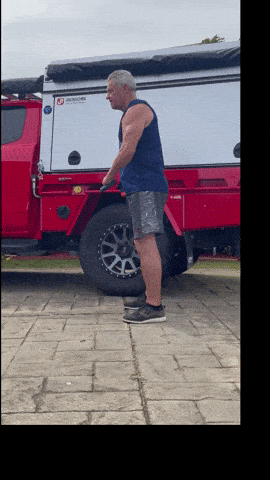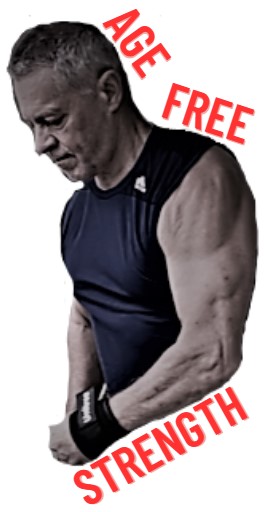Train Around an Injury – Don’t Avoid Training Altogether
Below is a YouTube video that summarizes my cracked ribs scenario and demonstrates the initial exercises. You will find time starts for each exercise in the routine table and the form descriptions below.
This 20-minute workout was designed during my recovery from cracked ribs — but its value goes well beyond that. Whether you’re managing an injury or just seeking a joint-friendly, ‘almost’ full-body portable strength session with minimal equipment, this might be exactly what you need.
Disclaimer: Depending on the nature of your injury and your training experience, this routine may not be suitable for you. Please seek medical advice before beginning, and stop immediately if you feel pain during any exercise.
Why I Created This Routine
When rib injuries strike, most traditional upper body movements — especially mid-torso pushes, pulls, rotations, or spinal flexion — become off-limits. But that doesn’t mean you have to stop training altogether.
Instead of focusing on what I couldn’t do, I reworked my approach to:
- Prioritize isolation-biased movements that allow me to focus on the target muscle while keeping my torso stable and relaxed
- Initially rely on resistance bands, bodyweight, and isometrics — all tools commonly used in rehab protocols
- Maintain consistency and recovery by initially limiting each exercise to one high-quality set
Routine Overview
The routine strategy purposely balances intensity, volume and recovery. While designed around a rib injury, this approach also aligns with research supporting more frequent, lower-volume training as more effective than many traditional workout protocols that hammer a muscle group once per week.
All exercises, except for the Bulgarian Split Squat, are bilateral (both limbs working concurrently) to enable torso stabilization.
For the dynamic resistance band exercises, I set the tension to get around 1 minute of time under tension, stopping just short of failure. Isometrics are held for one minute also. See the form notes in the exercise section below for more details.
The routine protocol summary:
- Done within 20 minutes
- Initially, uses only bands, isometric tension, and bodyweight – see this post link for our recommended bands
- Includes 6 one-minute “resting squats” spaced throughout — a powerful mobility tool and active recovery move
- Has minimal rest between other exercises
- The first 2 weeks is designed for daily use thanks to its 1 set-low volume (with adequate intensity) and minimal recovery time structure
- After 2 weeks, when I introduced progressive exercises and /or increased the volume, I trained every other day.
Routine Table and Exercise Form
This section tabulates the exercises, as done in the first 2 weeks after the rib’s injury. The form notes below the table detail the exercises and include the progressions after the initial 2 weeks (as I’m writing this post, I’m just starting week 4).
The table has the exercise demo start time in the video under the ‘Time’ header e.g. 23s is 23 seconds into the video and 1m10s is 1 minute 10 seconds.
| Exercise | Equipment | Time |
|---|---|---|
| Resting Squat | Body + Progression | 23s |
| Biceps Drag Curl | Bands + Progression | 28s |
| Triceps Push-Away | Bands + Progression | 36s |
| Resting Squat | Body | 23s |
| Bulgarian Split Squat | Body + Progression | 48s |
| Chest Palms Press | Isometric + Progression | 1m2s |
| Resting Squat | Body | 23s |
| Lateral Raises | Bands + Progression | 1m10s |
| Hamstring Drive | Isometric | 1m18s |
| Resting Squat | Body | 23s |
| Upper Back Pull-Apart | Bands | 1m26s |
| Ab Vacuum | Isometric | 1m34s |
| Resting Squat | Body | 23s |
| Shrugs | Bands | 1m41s |
| Standing Calf Raises | Body | 1m52s |
| Tibialis Contractions | Body | 2m2s |
| Resting Squat | Body | 23s |
Exercise Form Notes
With video time starts repeated.
For all dynamic range of motion exercises (bands and bodyweight) use a rep tempo that allows you to focus on the target muscle while keeping tension throughout the full range of motion - and helps keep your torso relaxed and stable.
My tempo is about 2 seconds for the contraction and 2 seconds extension (eccentric) stroke but slower is ok. Important for this rehab workout is gripping the bands for a moderate resistance with a time under tension at about 1 minute - while stopping just short of failure.
Resting Squat
Video time start 23s.
Repeated throughout the routine, the Resting Squat is one of the simplest and most effective ‘results for effort’ mobility drill around. I strongly recommend it for ankle, knee and hip mobility while also improving posture and your general ability and capacity to do everyday activities.
Resting squats are more than just a passive position — they are a daily tool to reclaim natural movement.
The version in the video is the passive resting squat:
- Stand with your feet a bit wider than shoulder width with your toes pointed out slightly
- Slowly lower your torso and relax into the deep resting position, letting your body sink into it – stay in this position for at least 1 minute
- If you have trouble – start by raising your heels and/or hold onto a support with a hand and/or only lower partially
- Be patient and over time you will enjoy the relaxing feeling you get from this simple but effective mobility drill
- Do it randomly instead of sitting on a couch or chair (e.g. while watching TV) and build up to at least 15 minutes per day total
Progressions
At the start of week 3, I mixed the passive squat with a semi-active version where, in the lowered position, I gently pushed my knees apart with my elbows – 30 seconds passive followed by 30 seconds push-aparts for the 1-minute exercise. This improves hip external rotation which is a common mobility issue.
I will wait until my ribs are fully recovered to re-incorporate the more active version with torso rotations while in the lowered position.
Click this post link for Mobility, Flexibility and Balance insights . Become a Member to unlock all of the Age Free Strength routines.
Biceps Drag Curl
Video time start 28s.
Place the resistance band under your feet. Hold the bands securely with your hands and lift your elbows while focusing on the Bicep’s contraction.
I find this version easier to keep my torso relaxed than the typical Bicep Curl that locks the elbows to your side and forces your core to stabilize the torso.
I use layered latex loop resistance bands that I find more versatile and ‘snap resistant’ than tube bands. As noted above, click this link for our recommended bands.
Progressions
After 2 weeks of resistance bands Drag Curls, I progressed to Unitree Pumps Cable resistance curls, which is one of the optimal Age Fee Strength exercises. However, with the rib’s recovery, I do the bilateral version (both arms curling concurrently) for better torso stability. I’m also increasing the volume and intensity by incorporating the Myo-Rep rest/pause protocol.
Myo-Reps are a great way to maximize muscle growth while minimizing workout duration. The Myo-Reps rest/pause protocol we favor takes the first 'activation' set of 15 reps close to failure followed by 5 deep breaths (about 15 seconds) and then mini-sets of 3 to 5 reps using the same weight resistance. Repeat the 5 deep breaths and mini-sets for 3 or 4 mini-sets and around 15 Myo-Reps total after the activation set.
As per previous posts and as detailed in the Members Area, constant cable resistance provides a resistance curve that aligns closely with the muscle strength curve – see demonstration below, done in a park near where we were staying.
For a description of our portable equipment, click this link including Unitree Pumps.
The constant cable resistance Bicep Curls are one of my favorite exercises. The setup is simple and enables torso stability while leaning into the curling motion.
Note that all of the Unitree Pump progressive exercise can be performed with loop resistance bands. It's different equipment with differing resistance curves but with the same anchor points.
Triceps Push-away
Video time start 36s.
Hook the resistance band onto a sturdy support above and behind your head. With the base of your back supported and keeping your torso relaxed and stable, face away from the anchor point, lock your elbows in position and push away and down keeping full focus on the Triceps.
Progressions
After 2 weeks of resistance bands Triceps Push-aways, I progressed to Unitree Pumps Cable version, which is one of the optimal Age Fee Strength exercises detailed in the Members Area – see demonstration below, done in a park near where we were staying. The Cable Triceps Push-Aways are done with the Myo-Rep protocol.
Bulgarian Split Squat
Video time start 48s.
This is the only unilateral exercise in this initial rib friendly routine as it lends itself to maintaining a relaxed and stable torso. Most leg movements in life are ‘one leg at a time’ which makes this exercise very functional also.
Perform the exercise with each leg for 1 minute of work (15 to 20 reps each leg and stopping just short of failure) or as much as you can handle. The bodyweight version alone is harder than it looks.
Although Quads biased it also works the Glutes. It is my favorite lower body exercise and is great for ankle, knee and in line hip mobility. If you have trouble with balance position yourself where you can hold on to something with a hand.
The Glutes biased reverse lunges and hip thrusts are out while my ribs are recovering as they put strain on my torso.
Progressions
Each week I’ve been raising my back leg more to increase the range of motion. After week 2 I also increased the sets and volume to 20 reps each leg immediately followed by 10 reps each leg. Most of you will find that challenging.
Chest Palms Press
Video time start 1m2s.
This simple Isometric exercise is rib friendly while being reasonably effective for your pecs.
Place your palms together in front of you at sternum height, raise your elbows to the same height and press your palms together. Do this for 1 minute total in 20 second blocks – starting with medium pressure, then medium hard pressure and for the last 20 second block go as hard as you can.
Important is to focus on the pecs trying to contract while being conscious of relaxing and stabilizing your torso. Doing this exercise while seated is fine also.
Progression 1
After 2 weeks of Isometric Palm Presses, I progressed in week 3 to Resistance Band Cross Press. Again, focus on the pecs doing the work while keeping your torso relaxed and stable. This exercise was done with 1 set for around 1 minute of work. See demonstration below.
Progression 2
At week 4 I progressed to the Unitree Pumps Cable Converging Press version, which is one of the optimal Age Fee Strength exercises.
With your lower back supported and your torso relaxed and stable, lean forward and push your hands down and across, starting at collar bone height until your hands meet at your sternum. I’m using the Myo-Rep protocol for this exercise.
See a demonstration below, done in a park near where we were staying. For more demonstrations of the Converging Chest Press, with our camping setup, click this link: Strength Training As We Age.
Lateral Raises
Video time start 1m10s.
For the Side Deltoid Lateral Raise I use a single loop resistance band gripped with my arms and hands down in front of my waist.
Keeping the hands in front and the torso relaxed and stable, raise both arms laterally until the hands are just under shoulder height. Return to the starting position keeping tension throughout the range of motion.
Progressions
At week 3 I progressed to the Unitree Pump Unilateral Raises which is one of the optimal Age Fee Strength exercises.
Below is the Unitree Pump version. For form notes click this link: Biomechanics and the Shoulders

Hamstring Drive
Video time start 1m18s.
The video demonstration looks like I’m just sitting on a chair but I’m actually driving my heels back into the chair legs while actively contracting the hamstrings.
Do this Isometric exercise for 1 minute total in 20 second blocks – starting with medium pressure, then medium hard pressure and for the last 20 second block go as hard as you can.
Important is to focus on the Hamstrings trying to contract, keeping the hips level and avoid arching the back – all while being conscious of relaxing and stabilizing your torso.
Upper Back Pull-Apart
Video time start 1m26s.
For the Upper Back Pull-Apart I use a single loop resistance band gripped with my hands extended in front of my shoulders.
Keeping the torso relaxed and stable, and with your arms extended at shoulder height, pull your hands apart until the band touches your chest. Return to the starting position keeping tension throughout the range of motion.
With my mid-lower back being the most vulnerable with the rib's injury, this is the only back exercise I am doing until I am fully recovered.
After week 2 I increased the Band Pull-Apart volume to 2 sets with 20 second’s rest between them.
Ab Vacuum
Video time start 1m34s.
As for the Hamstring Drive, the video looks like I’m just sitting on the chair, but I am contracting my Transverse Abdominus as an Ab Vacuum Isometric exercise.
With my injured ribs I'm avoiding spinal flexion associated with dynamic Ab exercises, or even planks where the core has to work to stabilize the torso.
The Transverse Abdominus acts as sort of a ‘girdle’ for the abdomen, provides spinal support, assists in breathing and participates in torso coordination. Although you can’t see this muscle it does have functional importance.
This isn’t about crunching — it’s about internal bracing. Think of drawing your bellybutton toward your spine.
For more Form Notes click this link: Best Abs and Core Exercises – which includes the image below by one of the greatest pro body builders of all time, Frank Zane. As you can see – he perfected it.

Shrugs
Video time start 1m41s.
Of all the initial Rib workaround exercises, this Upper Trapezius Shrug exercise is the one I’m most cautious with. If I feel rib discomfort I stop, but in general it has been ok.
Place the Bands under each foot (bands doubled over), keeping your back vertical bend at the knees and grab the bands. Stand up straight while keeping your back vertical and torso relaxed, then shrug both arms up and down for around 1 minute until close to failure.
For this exercise I will stay with 1 set until my ribs fully recover.
Standing Calf Raises
Video time start 1m52s.
Did you know your calves act as your second heart?
The gastrocnemius and soleus muscles help pump blood back up to your heart — keeping your circulation healthy, especially if you sit all day. Ignoring your calves doesn’t just affect your physique — it can lead to swelling, varicose veins, and even thrombosis.
There is no better exercise for the calves than standing calf raises where you get a good stretch in the down position. Pause at the top briefly to fully engage the muscle — don’t bounce through reps.
My typical calf exercise is one leg at a time while leaning forward and supporting my torso with my arms, but that version puts a bit of strain on my ribs.
For the bilateral standing bodyweight calf raise version in the video I do a bit more than 1 minute but still stop just short of failure.
Tibialis Contractions
Video time start 2m2s
This Tibialis (shin muscles) exercise is often overlooked — but don’t skip it.
This simple exercise helps improve ankle stability, balance, and overall lower-leg strength while reducing the risk of shin splints and other common lower-leg injuries.
Lean back against a wall with your feet out and raise and lower the balls of your feet, pivoting on your heels.
Conclusion
Injury doesn’t have to mean inactivity.
This cracked ribs routine helped me stay strong, mobile, and motivated — and it might do the same for you. It’s not about pushing through pain, but about working with your body and choosing smart, biomechanically sound movements that support recovery rather than stall it.
If you’ve enjoyed this post, explore the other free content on AgeFreeStrength — or become a Member to unlock complete Routines, Optimal exercise guides, Mobility drills, all future content and support for training at any age.
And don’t forget to check out the embedded YouTube video and try the routine. Let me know how you go.

Great content Jeff! Keep it up!